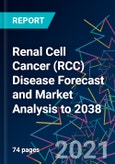Latest Key Takeaways
- The publisher estimates that in 2018, there were 338,000 incident cases of renal cell carcinoma (RCC) worldwide in those aged 40 years and older, and forecasts that number to increase to 384,000 cases by 2027.
- The majority (75%) of RCC cases have a clear cell histology (ccRCC), to which most first-line treatment regimens are specialized. The next most common histology is papillary RCC, comprising 15% of RCCs.
- Nearly all pharmacological interventions are administered in metastatic RCC. Sutent may occasionally be prescribed as a postoperative adjuvant therapy in locoregional disease, but the typical approach is nephrectomy alone.
- Patients receiving first-line treatment are organized by prognostic risk criteria, as determined by several clinical parameters. This is used to stratify patients into poor, intermediate, and favorable risk categories, which subsequently guide physicians in choosing the appropriate treatment regimen.
- The most prominent drug class in RCC currently is tyrosine kinase inhibitors (TKIs). While Nexavar inhibits both intracellular and cell surface kinases, other agents (Sutent, Votrient, Lenvima, Cabometyx, and Inlyta) block members of the receptor tyrosine kinase (RTK) superfamily associated with angiogenesis and tumor cell proliferation, most notably VEGFR and PDGFR. In addition to targeting VEGFR/PDGFR, Cabometyx targets the RTKs MET and AXL. Inlyta and Tivopath, on the other hand, are specific for members of the VEGFR family.
- Other drug classes in RCC include inhibitors of the mammalian target of rapamycin (mTOR), a serine-threonine kinase. The mTOR pathway is dysregulated in several human cancers, and Afinitor (an mTOR inhibitor) was the first pharmacological agent available as a therapy for subsequent-line metastatic RCC. Inhibition of mTOR has also been shown to reduce expression of VEGF.
- PD-1 antagonist Opdivo was the first immune checkpoint inhibitor (ICI) approved in RCC and has quickly become a standard of care (SOC) in many treatment settings following demonstrable clinical benefits over earlier therapies. Recently, the agent has been challenged in first-line ccRCC by rival PD-1/PD-L1 antagonists Keytruda and Bavencio, but has been boosted by the approval of the CheckMate 9ER regimen and remains the only drug of its class in subsequent-line settings.
- Combinations of checkpoint inhibitors and TKIs dominate in first-line ccRCC. Opdivo is approved in combination with Yervoy or Cabometyx, while Keytruda and Bavencio are approved in combination with Inlyta. Moreover, a similar doublet of Keytruda and Lenvima is also likely to be launched.
- Sutent is set to lose ground due to both newer, more effective treatments and imminent biosimilar erosion. Previously the SOC across many treatment settings, the pivotal trials of several newer therapies, which include checkpoint inhibitors Keytruda, Opdivo, and Bavencio, and the RTK inhibitor Cabometyx, have demonstrated significant clinical benefit over Sutent in the first-line setting. Keytruda and Cabometyx have also demonstrated benefit over Sutent in subsequent-line settings.
- Sutent is also threatened by the expansion of ICIs for postoperative treatment of locoregional disease, where it has largely been able to avoid competition. Approval in this area has proven difficult, with several other TKIs previously failing to expand into the setting. Due to concern over its risk/benefit profile, Sutent is only listed as a Category 3 treatment in this setting by the NCCN and was rejected by the EMA. It is thus infrequently administered. Phase III trials of ICIs Keytruda, Opdivo, and Tecentriq are ongoing and, if positive, one or more of these agents could finally displace Sutent and perhaps renew interest in adjuvant treatment of locally advanced RCC.
- Sutent, along with Cabometyx, remains commonly prescribed in first-line non-ccRCC, although this is partly due to a lack of data for newer treatments in the less common histological subtypes of RCC. Opdivo and Yervoy are the only checkpoint inhibitors available in this setting but are only recommended for sarcomatoid RCCs.
- mTOR inhibitors along with most TKI monotherapies are being gradually eclipsed in metastatic RCC by ICI-based combination therapies. However, some TKIs will be able to retain market share through incorporation into these combination regimens. This has been the case with Inlyta, which has seen improved uptake through use in first-line combination therapies that also incorporate checkpoint inhibitors Keytruda and Bavencio.
- A minority of other TKIs are also well positioned to improve their uptake through use as combination therapies alongside checkpoint inhibitors in a similar manner to Inlyta. Already well appraised as a monotherapy in second-line disease and in combination with Opdivo in first-line disease, Cabometyx has prospective label expansions as a combination therapy alongside Tecentriq, and alongside pipeline histone deacetylase inhibitor abexinostat. Similarly, Lenvima, presently available either as a monotherapy or a combination therapy with everolimus, may also be employed in the coming years in a combination therapy alongside Keytruda.
- Many older drugs are subject to patent expiries. VEGF inhibitor Avastin is already facing erosion from bevacizumab biosimilars, and the mTOR inhibitor Afinitor has been widely genericized. Other drugs set to follow in the near future include mTOR inhibitor Torisel, along with TKIs Sutent, Nexavar, and Votrient.
- Pipeline therapies of note include the PD-L1 inhibitor Tecentriq and the potential first-in-class launch of the HIF-2α antagonist belzutifan.
Table of Contents
OVERVIEW
DISEASE BACKGROUND
TREATMENT
EPIDEMIOLOGY
KEY REGULATORY EVENTS
LICENSING AND ASSET ACQUISITION DEALS
CLINICAL TRIAL LANDSCAPE
FUTURE TRENDS
RECENT EVENTS AND ANALYST OPINION
BIBLIOGRAPHY
LIST OF FIGURES
LIST OF TABLES








